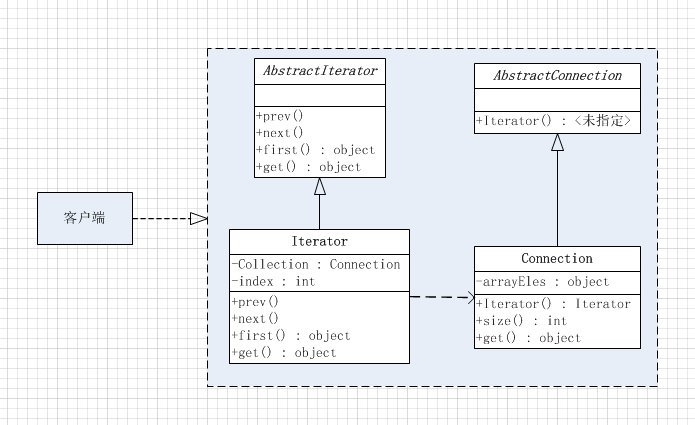迭代子模式:定义
迭代子模式,又称游标模式,是一种用于对聚集进行顺序访问规则的模式,是一种行为模式;它用于提供对聚集对象的一种统一的访问接口,使客户能够在不了解聚集对象内部结构的情况对聚集对象进行访问。它涉及两个部分,一个是聚集对象,一个迭代子对象,迭代对象(Iterator)用于提供访问聚集对象的标题访问方法;
主要组成角色:
- 抽象迭代子角色:用于定义访问聚集的标准方法
- 具体迭代子角色:用于实现访问聚集的访问方法
- 抽象聚集角色:用于定义公共的聚集对象访问方法,主要的有迭代对象,当前元素获取,聚集对象大小;
- 具体聚集角色:用于实现聚集对象的公共访问;
基础代码:
//抽象聚集对象类
public Collections() {
this.arrs = ['xx'];
this.iterator = function() {
console.log('需要返回一个Iterator对象');
return null;
};
this.size = function() { //Iterator 需要引用
this.arrs.length;
}
this.get = function(idx) { //Iterator 需要引用
return this.arrs[idx];
}
};
//迭代对象
public Iterator (colls) {
this.colls = colls;
this.index = 0;
this.next = function() {
if > this.colls.size() //引用
this.index ++ ;
}
this.prev = function() {
//if < 0
this.index--;
}
this.get = function() {
this.colls.get(this.index); //引用
}
//more
}迭代子模式结构图

实例
1. 抽象迭代角色
function abstractIterator() {
this.prev = functiojn() {
};
this.next = function() {
};
this.first = function() {
};
this.hasNext = function() {
};
this.get = function() {
};
}
2. 具体迭代角色
function Iterator(colls) {
this.colls = colls;
this.index = 0;
};
Inteator.prototype = abstractIterator.prototype;
Inteator.prototype.prev = function() {
if (this.index > 0)
this.index --;
};
Inteator.prototype.next = function() {
if (this.index < this.colls.size()) {
this.index++;
}
};
Inteator.prototype.first = function() {
this.index = 0;
};
Inteator.prototype.hasNext = function() {
return this.index < this.colls.size();
};
Inteator.prototype.get = function() {
return this.colls.get(this.index);
};3. 抽象聚集角色
function abstractCollection() {
this.iterator = function() {
return null;
};
}4. 具体实现聚集角色公共方法
function Collection() {
this.arrars = ['XXX', 'yyy', 'ZZZ'];
};
Collection.prototype = abstractCollection.prototype;
Collection.prototype.iterator = function() {
return new Iterator(this);
};
Collection.prototype.size = function() {
return this.arrays.length;
};
Collection.prototype.get = function(index) {
return this.arrays[index];
};5. 客户端使用
function Client() {
var colls = new Collection();
var iterator = colls.iterator();
for (iterator.hasNext()) {
console.log(iterator.get());
iterator.next();
}
};其他说明
把聚象对象的访问逻辑统一到迭代对象里,让客户可以不用了解聚象对象的结构,就可以一种统一的方式访问,聚集与业务逻辑的解耦!